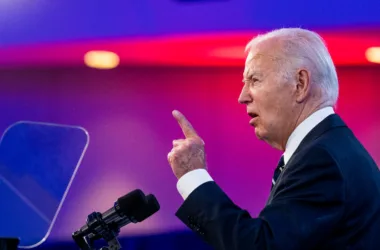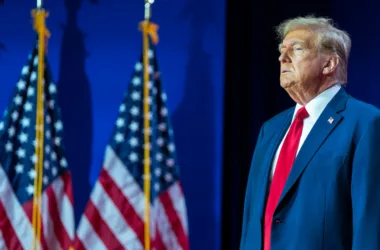Since taking over the United Auto Workers union in April, Shawn Fain has demanded increased government subsidies for the auto industry and resurrected the class-warfare rhetoric the labor union had abandoned decades ago.
A relative unknown less than a year ago, Mr. Fain is now one of the most prominent figures in the labor movement, overseeing the first-ever strike simultaneously against the Big Three automakers. His goal is to dramatically reshape wage scales and working conditions that would forever change automobile manufacturing.
Emerging as an underdog candidate in the race for UAW president, Mr. Fain won in a runoff election as a reform candidate with a fiery progressive message.
He pledged a more militant approach at the bargaining table. He told UAW members their “one and only true enemy” are multi-billion-dollar corporations who refuse to share profits.
That rhetoric has carried over into the UAW strike against General Motors, Ford and Stellantis, the parent company of Dodge, Chrysler and Jeep. Mr. Fain has cast the strike — which began Sept. 15 — as a battle between blue-collar workers and wealthy elites. He has punctuated his discourse with vehement attacks on the wealthy.
The strike expanded Friday to another Ford plant and GM plant where 7,000 more workers walking off the job. That brings the total to 25,000 of the UAW’s 146,000 workers on strike at 43 locations around the country.
Mr. Fain has said that anytime someone becomes a billionaire it represents the failure of U.S. economic policy.
“Billionaires in my opinion don’t have a right to exist,” he told UAW workers last month. “The very existence of billionaires shows us that we have an economy that is working for the benefit of the few, and not the many. … It feels like we’ve gone so far backward, that we have to fight just to have the 40-hour workweek back. Why is that? So another a–hole can make enough money to shoot himself to the moon?”
Mr. Fain has denied that he’s engaging in class warfare with such impassioned remarks.
But Jon Melrod, a former UAW worker who also served as a local union leader, says that’s exactly what it is.
“It is class warfare,” he said. “The gap between those at the top and the majority of people in the United States who don’t have access to millions of dollars feel like they are in a class war and have to take back their humanity and working conditions in which they could thrive.”
Mr. Fain’s rhetoric echoes legendary UAW President Walter Reuther, who led the union from 1946 to 1970. The son of a German socialist, Mr. Reuther received an early education in socialism from his dad, including a visit to Socialist Party leader Eugene V. Debs in prison. He later married a socialist activist and began a career with the UAW.
Although he worked to purge communists and socialists out of the UAW, Mr. Reuther also used his position to advocate for national health care, economic redistribution, and government-backed job security. All were radical ideas for post-war America.
After Mr. Reuther’s death, Leonard Woodcock became president of the UAW. His father was also a socialist and Mr. Woodcock himself was considered a rising member of the Socialist Party until he resigned in 1940 in a dispute over whether the U.S. should remain neutral in war in Europe.
The UAW’s leadership and ties to socialism date back to the late 1930s, when Homer Martin, an avowed socialist, ran the union.
While labor experts say Mr. Fain’s rhetoric doesn’t rise to the level of socialism, it is the first time a UAW president depicted their efforts as a battle between the classes since socialists were running it.
“Under the class of capitalism, the owning class is trying to maximize profit at the expense of the working class,” Mr. Melrod said. “It really is the class division that Shawn Fain is seeking to lessen and make more equitable.”
Paul Clark, who teaches labor relations at Pennsylvania State University, says the recent UAW presidents who didn’t engage in the aggressive, progressive rhetoric of their predecessors were the outliers, not Mr. Fain.
“This is not a big change for the UAW,” he said. “You didn’t hear this from the UAW of the last 10 or 20 years, but you don’t have to go back too far to see presidents who had this populist message.”
The UAW abandoned its hardcore progressive message in the 1970s amid waning influence and several hits to its reputation. Membership declined due to factory closings, global competition and cheaper labor outside the U.S. As its clout diminished, workers endured contract concessions and layoffs.
Compounding the UAW’s problems, a corruption scandal that played out over the past decade resulted in former UAW presidents being convicted of stealing union funds for their personal use.
The scandal led to a new election — supervised by a court-appointed monitor — for UAW president earlier this year. Mr. Fain’s campaign raised eyebrows with his fervent far-left rhetoric. He later raised eyebrows by refusing to shake hands with the automaker CEOs at the start of bargaining, a decades-long tradition, and threw the Stellantis offer into a trash can before walking out of a meeting.
“It left [automakers’] management completely flabbergasted. It was a total shock to them because they weren’t ready for someone to talk about class war,” Mr. Melrod said. “Fain tapped into exactly how the workers feel — resentful.”
Yet, some of the UAW’s current demands would make their World War II-era socialist leaders bristle, such as Mr. Fain demanding autoworkers get 40 hours of pay for a 32-hour workweek.
Mr. Fain and his team say the demand is a callback to the UAW’s roots as a progressive labor group that fought for improved quality of life. The proposal has stalled in negotiations with the Big Three, who say it would hurt productivity, making them less profitable, and limiting what they can pay employees.
“Reuther wanted the companies to do well. He wanted workers to participate in automakers’ profits and as part of that participation, he argued that the workers owed the company productivity. Reuther would tie wage increases to productivity so the union and company could prosper simultaneously,” said Marick Masters, who teaches labor relations at Wayne State University.
Mr. Clark said the automakers played into Mr. Fain’s hands by dolling out massive salaries to their CEOs and other top executives.
According to Securities and Exchange Commission filings, General Motors CEO Mary Barra made nearly $29 million last year, while Stellantis CEO Carlos Tavares made about $24.8 million and Ford CEO Jim Farley made about $21 million.
The median CEO pay package for S&P 500 companies was $14.5 million last year and three automobile manufacturers earn roughly 300 times the median or average auto worker earned.
The average UAW made about $28 per hour last year, according to data from the Bureau of Labor Statistics. That is a wage increase of about $1 per hour from 2021.
But not all workers make $28 per hour, some make more, while others earn far less. Supplemental workers at Stellantis, for example, earn between $15.78 per hour to $20 per hour, according to company data.
The UAW is striking for a more than 40% pay increase over the next four years among other demands, which include restoring workers’ retirement benefits and 40 hours a week pay for a 32-hour work week.
They say the proposed pay increase only slightly exceeds the combined 40% increase in CEO compensation over the past four years at the Big Three.
Yet, a review of SEC filings shows that the Big Three’s CEOs enjoyed massive salaries, their pay increases did not exceed 40% compared to just four years ago.
Ms. Barra earned 34% more in 2022 than she did in 2018, while Mr. Farley earned 21% more than Ford’s previous CEO did that year and Mr. Tavares earned about 24% less last year than his predecessor.
Still, at his current salary, Mr. Tavares earns 365 times that of the average Stellantis employee.
The automakers have argued that high salaries are justified because they are tied to a company’s performance and most of their compensation is tied to corporate stock and bonuses incentives. For example, Ms. Barra’s base salary is $2 million.
“Fain is trying to remind people of the problem of income inequality, which has grown tremendously over the years. His rhetoric is consistent with the UAW traditions and culture,” Mr. Clark said.









